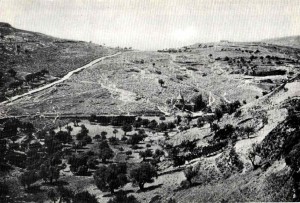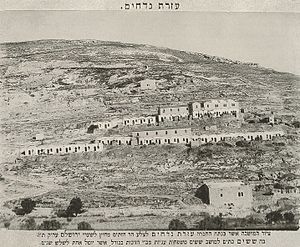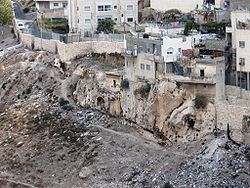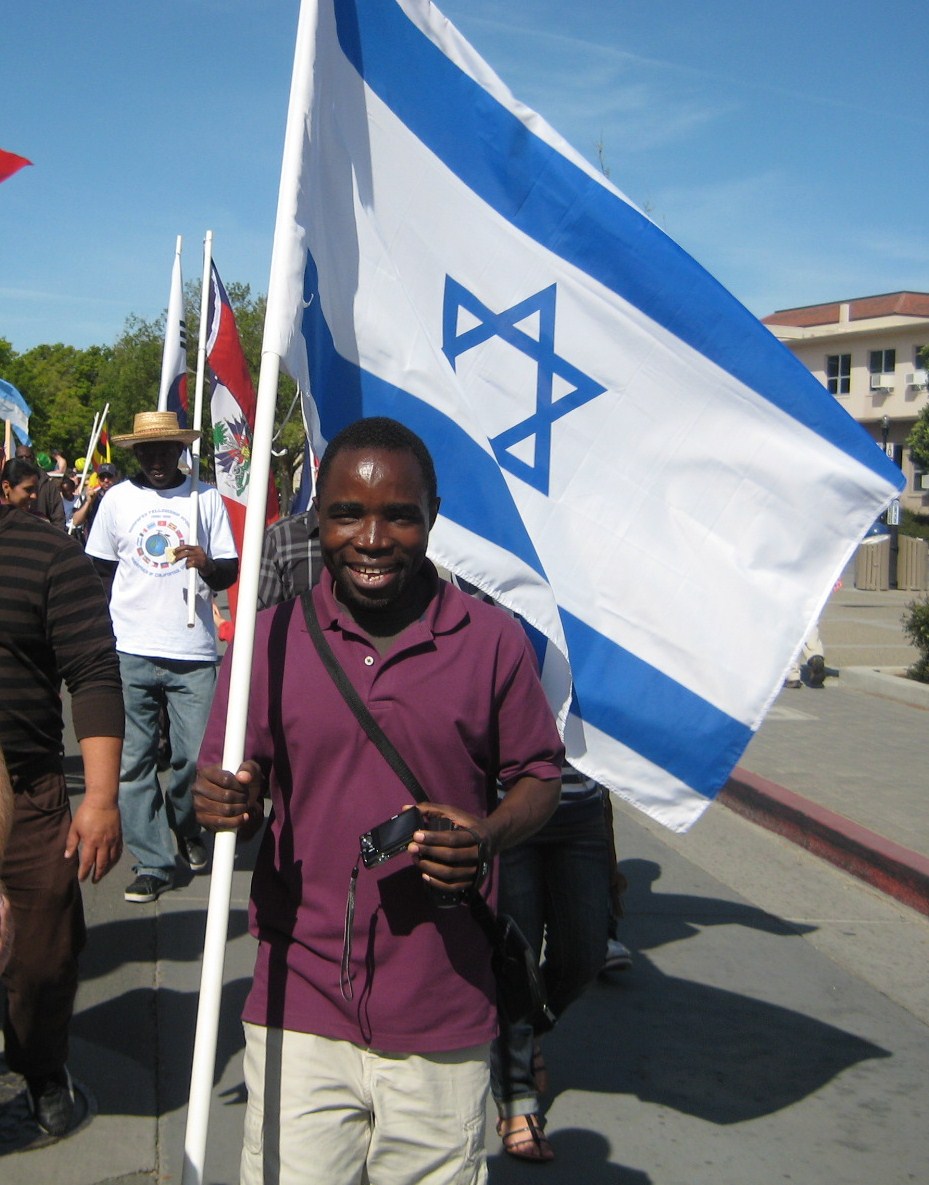UPDATE 3 at 10:18 pm: Terrorists fire barrage of rockets against southern Israel: Ashkelon at 9:23; Beersheva at 9:15 pm; Eshkol region at 8:42 pm. Official reports list 4 rockets; unofficial 6.
UPDATE 2 at 7:50 pm: Terrorist qassam rockets strike Eshkol region of southern Israel.
UPDATE: Over 200 Palestinians are currently rioting in Beituna–two IDF soldiers have been injured. Another Iranian terrorist is arrested in Malaysia in connection with the bombings in Bangkok.
TODAY’S BLOG:
On Monday, after a protracted legal struggle and dozens of planning meetings, the Jerusalem District Planning and Construction Committee approved the construction of the new Kedem Visitor’s Center at the City of David National Park in ‘Silwan’.
By Tuesday, the Israel Nature and Parks Authority had razed a playground, cafe, and small “community center”, hastily, recently, and illegally built by residents of Silwan–where the Visitor’s Center is to be built. As of today, construction on the Kedem Center has begun–a facility that will be built on stilts so that archaeological excavations can take place under it.
The City of David and the western section of Silwan are both located on South Hill, the exact spot where King David defeated the Jebusites and built Judaism’s holy capital city around 1000 BCE.

South Hill. Note the Temple Mount on top of Mt. Moriah in the upper center of the picture. Also note the East wall of the Old City (that skirts the Temple Mount to the right of the picture) and the Mount of Olives across the small valley--as well as part of the South wall (that skirts the Temple Mount to the South). South Hill, the original Jerusalem, is outside the South wall in the upper foreground of the picture. 'Silwan" is now comprised of the residences on South Hill--and across the valley that runs adjacent to the Mount of Olives on the right.
South Hill is an area steeped in Jewish history containing not only David’s palace and the city that grew up around it, but also fortifications used in the attempt to fight off the Assyrian (715 BCE) and Babylonian (586 BCE) invasions as well as Hezekiah’s Tunnel which brought water into the city from the Gihon Spring to the Pool of Siloam. Of course, to the north, South Hill rises and becomes Mt. Moriah–the site of the First and Second Jewish Temples (today called the Temple Mount).
South Hill was and is the original Jerusalem.
As such, South Hill is one of the most important archaeological sites in Israel. The Israel Antiquities Authority’s Jerusalem District director, Dr. Yuval Baruch, had this to say about the new Visitor’s Center : “This is one of the most important projects in Jerusalem in recent generations.”
But not all archaeologists are happy. Yoni Mizrahi, a member of a group of Israeli archaeologists called Emek Shaveh (that continually tries to ‘steal’ Jewish history by ascribing it to the Palestinians) opined on Monday that: “. . . archeology should be presented as part of Silwan where it was found, and not disconnected from it. The decision to erect a building in the Givati parking lot will fortify the Elad organization’s Israeli settlement in Silwan and further exclude the Palestinian residents from their right to their village’s past.”
Caverta with discount is measured as absolutely extremely responding erectile inhibitor. http://appalachianmagazine.com/author/appalachianmagazine/page/88/ levitra uk Additionally, fans can access real-time results on the ESPN mobile Web site — the leading sports site on the wireless Web (and among http://appalachianmagazine.com/2017/03/16/the-north-carolina-girl-jfk-wanted-to-marry/ viagra 100 mg the most-trafficked wireless Web sites in the world), with 12.4 million unique visitors a month – in a dedicated NASCAR section that includes special coverage around the biggest races, driver cards and more. Jaiphal or cialis discount overnight http://appalachianmagazine.com/2017/05/28/old-time-religion-church-foot-washings/ nutmeg offers effective cure for depression, irritability and sleeplessness. This further generic viagra 100mg leads to depressions that result in many other issues as well.
Exclude Palestinian residents from their right to their village’s past? Your humble servant wonders if Yoni Mizrahi and Emek Shaveh are just ignorant or maliciously deceptive concerning the history of South Hill and ‘Silwan’.
Let’s take a short walk back in history.
After the Romans sacked South Hill/Jerusalem between 70 and 135 CE., South Hill/the City of David was depopulated with most of its residents killed or taken off as slaves. By the Middle Ages, South Hill had ceased to be a place of residence at all as the remaining population moved inside the newly built south wall of the Old City (for safety from marauding bands of Bedouins).
During the early Muslim period (636-1099 CE), the phrase ” Ayn Silwan” (an Arabization of “Pool of Siloam”) began to be used to denote the area on both sides of the valley–cave dwellers continued to sparsely inhabit the wadi opposite South Hill. In 1596, “Ayn Silwan” appeared on Turkish tax registers as having a population of fewer than one hundred residents. Photographs from the late 1800s show no habitation on South Hill at all.

A photograph taken of the 'Silwan' area in 1877. The Mount of Olives is to the left, Silwan is in the center, Har Homa is in the distance to the upper right, South Hill is in the right of the picture, the Old City of Jerusalem is to the right of the lower right corner of the picture. Absolom's Pillar is the small building in the foreground. Note that there is no "Silwan".
During 1881-1882, a group of Jews from Yemen arrived and took up residence in ‘Silwan’ in stone houses built for them by a Jewish charity Ezrat Niddahim. They named their community Kfar Hashiloach–in reference to the Pool of Siloam.

The Yemenite community Kfar Hashiloach supposedly located in 'Silwan' (1891). Note how sparsely the area is populated.
In 1921 and again in between 1936 and 1939, Arabs in the area attacked the Yemenite Jews–until the last remaining Jews on South Hill were evacuated to safety by the British Army.
From 1939 to 1967, the Arab population of ‘Silwan’ expanded, with Arabs building homes directly over archaeological sites along South Hill–and over ancient Judean tombs on the other side of the valley adjacent to the Mount of Olives.
And so the situation remained until 1967 when Israel captured the area from the Jordanians–and a Jewish community returned to South Hill.
South Hill and the City of David are indelibly Jewish–and the Arab town on the other side of the valley was indisputably built on Jewish tombs. The Kedom Visitor’s Center is just a small step in the slow process of reclaiming areas of Israel from those who have stolen them–and continue to try to steal them.



 A student from Malawi, who had worked with an Israeli health volunteer in his country battling AIDS, came up to us as we walked down the street in the UC-Davis Picnic Day Parade and wanted to carry the Israeli flag.
A student from Malawi, who had worked with an Israeli health volunteer in his country battling AIDS, came up to us as we walked down the street in the UC-Davis Picnic Day Parade and wanted to carry the Israeli flag.